Hacienda, Russian River, Sonoma, California
THE REACH
RUSSIAN RIVER REACH
the other Russian River
the other Russian River
There is much written about the great resorts of Rio Nido, Guerneville, and Monte Rio. But there is another stretch of river with a very different flavor. THE REACH from Mirabel Park to Korbel. This roughly four miles of river has been a fantastic playground and home to many since the train arrived in 1876. And there are good reasons.
Our stretch of the river offers balance. We have the expected river and redwoods, but we also have agriculture and industry. Vineyards have replaced hops as the crop of choice and cover the ground adjacent to River Road or stretch along the west side of the river. Korbel, once a small village and the terminus of the NWP Railroad in 1876, produces 1.5 million bottle of Champagne a year.
We have three public beaches, Steelhead, Mom's and Sunset. Campgrounds like Mirabel, River Bend, Schoolhouse and Odd Fellows make our stretch accessible to more people.
Also THE REACH has location balance. We are roughly equidistant from Healdsburg, Santa Rosa and the Pacific Coast. Far enough from the bustle of the city without being so far that going to a city requires extra thought.
There is the East Reach with communities along River Road from Mirabel Park to Russian River Terrace. There is the West Reach from Hacienda to Korbel. And in the center is the pivoting point for THE REACH, Hacienda Bridge.
The Russian River Reach is the Russian River that doesn't usually get talked about, but it is time to change that.
Here are bits of interesting information on areas within THE REACH other than Hacienda.
The full web site for the REACH can be expired here:
www.rr-reach.com
Our stretch of the river offers balance. We have the expected river and redwoods, but we also have agriculture and industry. Vineyards have replaced hops as the crop of choice and cover the ground adjacent to River Road or stretch along the west side of the river. Korbel, once a small village and the terminus of the NWP Railroad in 1876, produces 1.5 million bottle of Champagne a year.
We have three public beaches, Steelhead, Mom's and Sunset. Campgrounds like Mirabel, River Bend, Schoolhouse and Odd Fellows make our stretch accessible to more people.
Also THE REACH has location balance. We are roughly equidistant from Healdsburg, Santa Rosa and the Pacific Coast. Far enough from the bustle of the city without being so far that going to a city requires extra thought.
There is the East Reach with communities along River Road from Mirabel Park to Russian River Terrace. There is the West Reach from Hacienda to Korbel. And in the center is the pivoting point for THE REACH, Hacienda Bridge.
The Russian River Reach is the Russian River that doesn't usually get talked about, but it is time to change that.
Here are bits of interesting information on areas within THE REACH other than Hacienda.
The full web site for the REACH can be expired here:
www.rr-reach.com
EL MOLINO
Gen. Mariano Vallejo divided up land north of San Francisco into land grants sanctioned by the Mexican government. He granted his brother-in-law, Juan Bautista Rogers Cooper (better known as Capt. John Cooper), the dashed line square shown on the below map in 1835. Cooper had started the first water-powered, commercial sawmill (Molino) in California at this site. So the land grant was called El Molino (The Mill) - aka Terreno Prentendido (Intended Land.) Hacienda was outside of the grant.
The mill was a big investment, $10,000 ($275,000 in 2017) and it was washed away in a flood in 1840.
The fort of Tahuiyumi is shown on Mill Creek (now Mark West Creek.) It was built by colonists from Mission Sonoma in 1830.
The site is now the location of Mirabel Park.
The mill was a big investment, $10,000 ($275,000 in 2017) and it was washed away in a flood in 1840.
The fort of Tahuiyumi is shown on Mill Creek (now Mark West Creek.) It was built by colonists from Mission Sonoma in 1830.
The site is now the location of Mirabel Park.
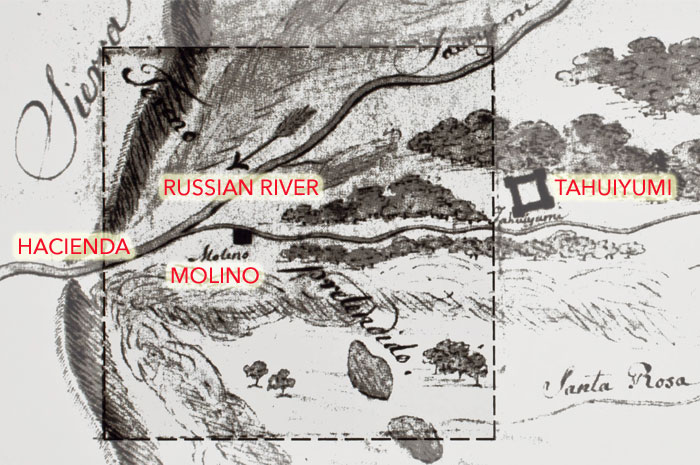
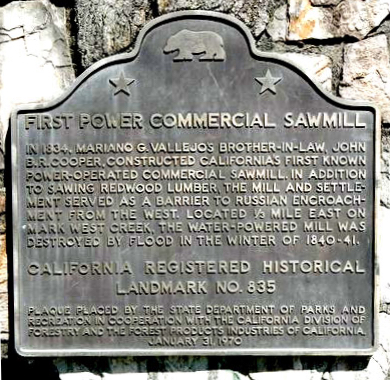
1834. California's first known water powered sawmill was located on Mill Creek, now Mark West Creek, near Mirabel Park.
KORBEL
The Czech Korbel brothers bought their property from Anthony McPeak, built a successful lumber mill and community. They were a primary force in getting the railroad into the redwoods trees growing along the Russian River. Of course, they eventually created a Champagne making factory, now owned by a different corporation.
The current company also operates a very interesting history tour that is free and provides an additional perspective on a bit of what is written here, only with the focus being the Korbel brothers. The tour starts in what is, apparently, the original train station.
I have to note that the tour does delicately skip over The Wasp, a political satirical publication from the Korbels. While it certainly reeks of racism, it is more complicated than mindless prejudice. Far more complicated than I wish to go into. It has fantastic surreal illustrations. If interested, here is a site: http://www.foundsf.org/index.php?title=WASP:_Racism_and_Satire_in_the_19th_Century
I will add that in my research, the Korbel Brothers were not very active in this region, outside of running a profitable business. Their minds were in San Francisco. The families that were most active in developing the area, especially with the second generations, were the McPeaks, the Ridenhours, the Walls, and the Browns.
The current company also operates a very interesting history tour that is free and provides an additional perspective on a bit of what is written here, only with the focus being the Korbel brothers. The tour starts in what is, apparently, the original train station.
I have to note that the tour does delicately skip over The Wasp, a political satirical publication from the Korbels. While it certainly reeks of racism, it is more complicated than mindless prejudice. Far more complicated than I wish to go into. It has fantastic surreal illustrations. If interested, here is a site: http://www.foundsf.org/index.php?title=WASP:_Racism_and_Satire_in_the_19th_Century
I will add that in my research, the Korbel Brothers were not very active in this region, outside of running a profitable business. Their minds were in San Francisco. The families that were most active in developing the area, especially with the second generations, were the McPeaks, the Ridenhours, the Walls, and the Browns.
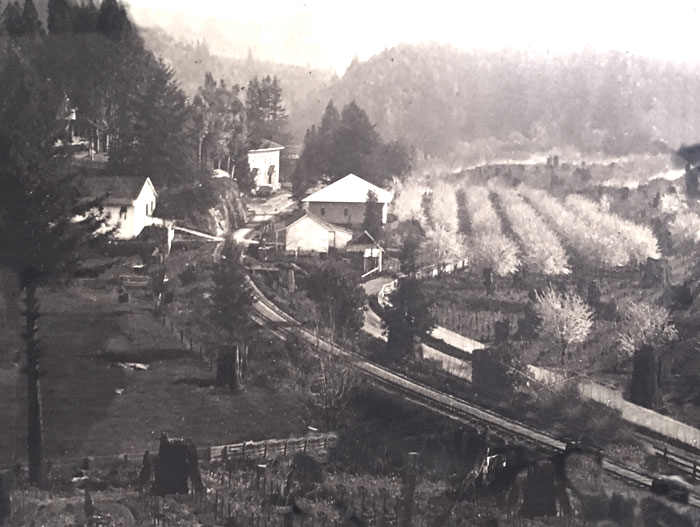
Korbel property, once the redwoods had all been harvested, turned into an orchard. They were entrepreneurs and tried various ways to make money before making Champagne. They are experimenting with grape production just this side of the orchard. The train tracks below the cliff in the center of the photograph is now the location of the tasting room.
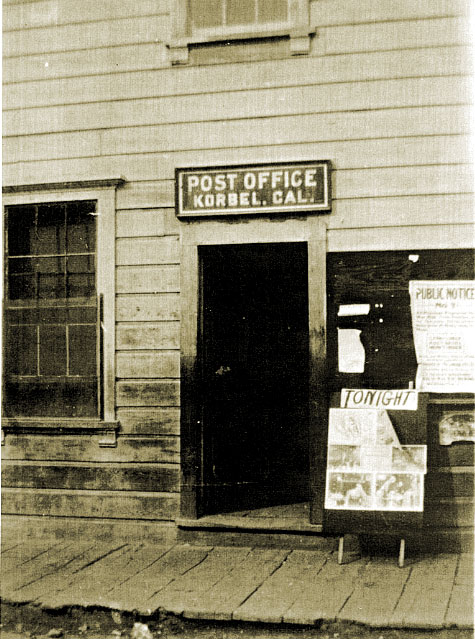
The first post office in the area was in Korbel shortly after the trains arrived in 1876. The postmaster was Anthony McPeak's son, M.A. McPeak.
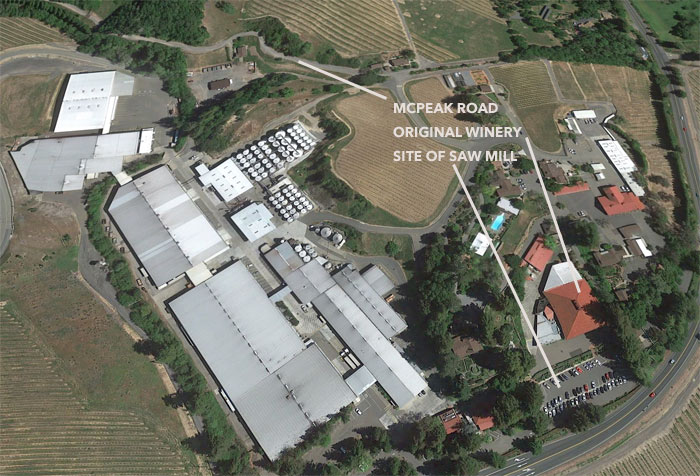
Now, Korbel is a financially successful producer of Champagne. It has been "grandfathered in" to use the word "Champagne" which otherwise is restricted to sparkling wine produced in the Champagne region of France.
WOHLER BRIDGE (The Red Hill bridge)
In 1922, the first true year round automobile bridge was built for this stretch of Russian River, The Red Hill Bridge, later referred to as the Wohler Bridge crossing the Wohler Ranch. This allowed for a much needed link between the Forestville train station and Healdsburg via Westside road. However, if one turned left onto Westside, it led to Cosmo three miles away. For the first time, Cosmo had to start planning for a parking lot.
The bridge was built after the Wall's Ford Bridge was badly damaged by a flood.
The bridge was built after the Wall's Ford Bridge was badly damaged by a flood.
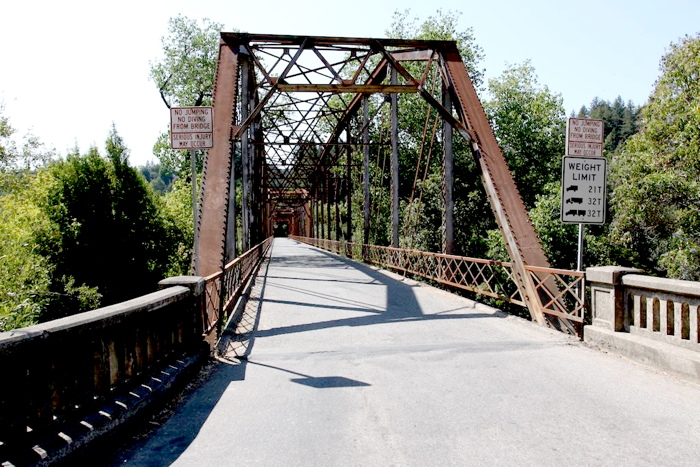
The Wohler Bridge, built in 1921-22 is still in use in 2017.
SUMMER CROSSINGS
I have already mentioned the Hacienda Summer Crossing Bridge that was in use starting in 1927 during summer until the railroad bridge was converted to automobiles in 1938. One old pier still sticks out of the water off Hacienda Beach. And further down this page I write about the Wall's Ford Bridge a mile and a half upstream from Hacienda at the foot of Mirabel Road.
There is one more, Esterville, aka Odd Fellows Summer Crossing. I think it was built about the same time as the Wall's Ford Bridge in the late 1800s. Remarkably enough it is still installed every summer as of 2017. The bridge is less than two miles from Hacienda, going west on River Road.
The road and bridge were reportedly built in this location due to a tendency of the Korbels to encroach onto the land of the Ridenhours with their vineyard expansion. The road is the dividing line between the two properties.
There is one more, Esterville, aka Odd Fellows Summer Crossing. I think it was built about the same time as the Wall's Ford Bridge in the late 1800s. Remarkably enough it is still installed every summer as of 2017. The bridge is less than two miles from Hacienda, going west on River Road.
The road and bridge were reportedly built in this location due to a tendency of the Korbels to encroach onto the land of the Ridenhours with their vineyard expansion. The road is the dividing line between the two properties.
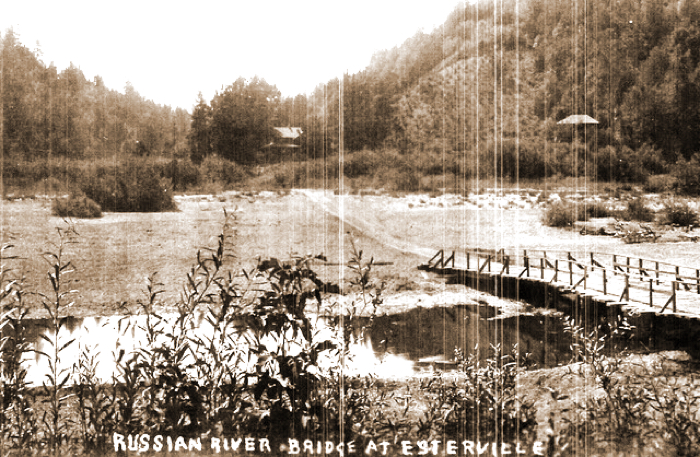
The reason that the summer crossing has continued to be used, I believe, is that the very popular campground, Odd Fellows, uses it as the only access to River Road unless one drives to Guerneville and crosses the bridge there. Esterville was a resort located at Korbel. Of course the current bridge is greatly improved (below.)
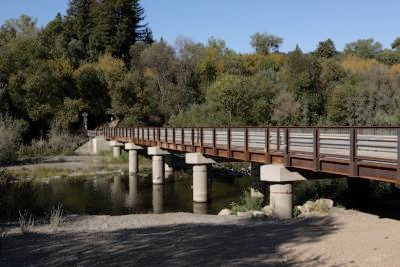
ODD FELLOWS CAMPGROUND
Located on the south side of the Russian River is the Odd Fellow's Campground. 1,100 cabin sites including rental units and 35 family camping spaces. Every renter must be sponsored by a member of the park. The 317 acres has road and street names with a connection to Odd Fellowship like Wildey, Colfax, Saratoga, etc. While many of the cabins and homes are located on the slopes and hills in the park, the flat land is utilized for the recreation area, camp grounds, rental units, store, teen club, clubhouse, outdoor theater, picnic area, playgrounds and barbecue area. The beach area is 350 feet of river frontage. The park manager and a guard and patrol service insures the privacy of the park.
Before the campground was built in the late '20s, it was a sawmill belonging to Fairfax Lumber Company. A road connected the Odd Fellows summer crossing to Summerhome Park.
Before the campground was built in the late '20s, it was a sawmill belonging to Fairfax Lumber Company. A road connected the Odd Fellows summer crossing to Summerhome Park.
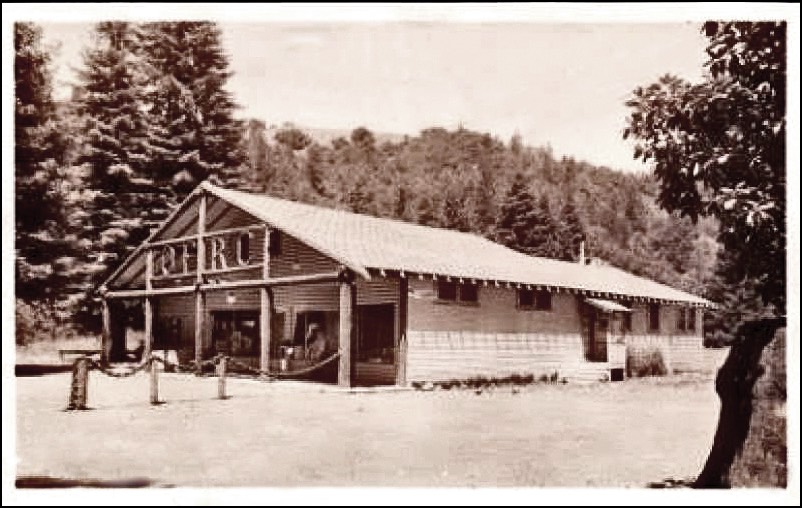
The Odd Fellow's Recreation Club main building was built in 1926. It burned in 2015 destroying a general store and burger cafe.
MT. JACKSON RESORT
The Mt. Jackson resort was northeast of Hacienda up the mountain. It got busted for selling bootleg liquor during prohibition a few times, and eventually was closed down. It reopened after prohibition ended and continued operation for many years advertising fine French Cuisine.
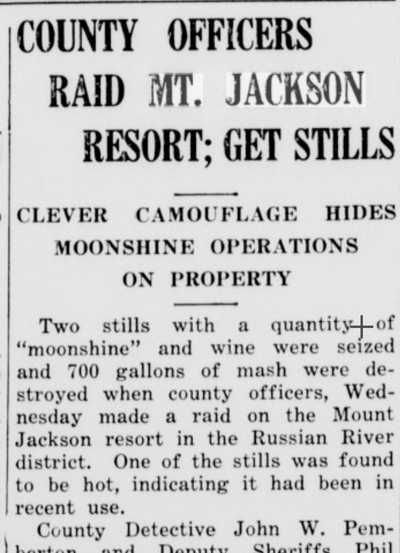
WALL'S SPRINGS
Little has been as elusive in my research as Wall's Springs. I do know that the Henry Chester Wall family and the McPeak family were friends and socialized together. It appears that the elder Walls were on the same wagon train from Missouri as the elder McPeaks so Henry and Anthony were likely long time friends.
The Wall's Springs resort was about a mile upstream on Westside road from Cosmo. In June 1893, there were 75 guests staying there. A new hotel had been built and other accommodations had been modernized.
One of the things that set it apart from other resorts was that it had hot springs. Sulphur, iron magnesia and salts were advertised as having healing properties.
In 1903, the Healdsburg Mining Company was sinking a shaft near Wall's Springs. About 100 feet down they struck… gold. They claim there is a great deal of gold ore on the property. An on-line search of mining found nothing about gold, though the Wall's Springs site is listed as having been a producer of Cinnabar and Mercury.
Anthony's adult children were pushing for a bridge for automobiles to get across the river. The ideal site was at the end of Mirabel Road at what was known as Wall's Ford, where the water was shallow enough to cross with a horse and buggy in the summer. A summer bridge for use by horses and on-foot had been built in 1898. In 1912, there was sufficient support on the west side for the county to hire Mervey-Elwell Bridge Co. to replace the old bridge. This gave a connection between Forestville and Healdsburg (and Cosmo) for automobiles until the construction of the all-year Wohler Bridge in 1922.
The Wall's were related by marriage to the Hobsons, who owned Hobson Farm before it became Cosmo Farm.
The Wall's Springs resort was about a mile upstream on Westside road from Cosmo. In June 1893, there were 75 guests staying there. A new hotel had been built and other accommodations had been modernized.
One of the things that set it apart from other resorts was that it had hot springs. Sulphur, iron magnesia and salts were advertised as having healing properties.
In 1903, the Healdsburg Mining Company was sinking a shaft near Wall's Springs. About 100 feet down they struck… gold. They claim there is a great deal of gold ore on the property. An on-line search of mining found nothing about gold, though the Wall's Springs site is listed as having been a producer of Cinnabar and Mercury.
Anthony's adult children were pushing for a bridge for automobiles to get across the river. The ideal site was at the end of Mirabel Road at what was known as Wall's Ford, where the water was shallow enough to cross with a horse and buggy in the summer. A summer bridge for use by horses and on-foot had been built in 1898. In 1912, there was sufficient support on the west side for the county to hire Mervey-Elwell Bridge Co. to replace the old bridge. This gave a connection between Forestville and Healdsburg (and Cosmo) for automobiles until the construction of the all-year Wohler Bridge in 1922.
The Wall's were related by marriage to the Hobsons, who owned Hobson Farm before it became Cosmo Farm.
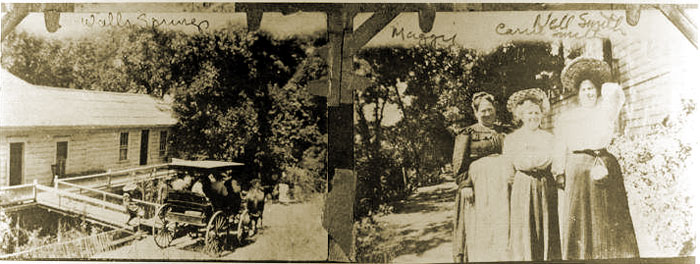
Wall's Springs Resort in 1915.
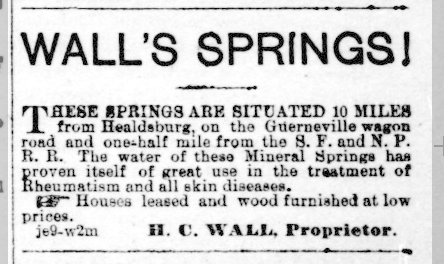
An 1883 advertisement.
WALL'S FORD and WALL'S FORD BRIDGE
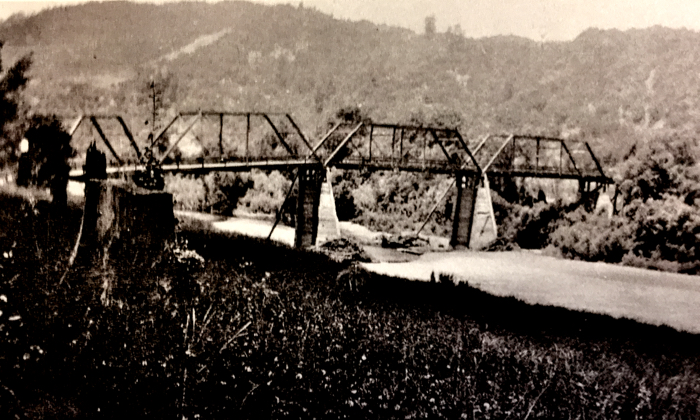
Nothing remains of the Wall's Ford Bridge. It was built starting in 1898 as a summer bridge, but construction stopped on the idea in 1922. A better bridge, the Wohler Bridge, then known as the Red hill Bridge, was built that year and is still in use in 2018.
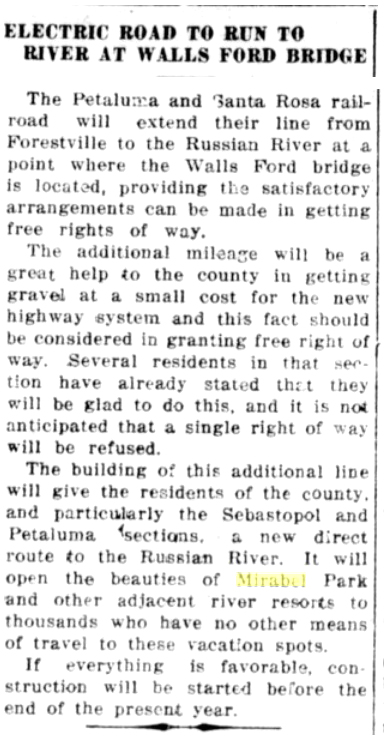
In 1919 there were plans to extend the electric train that connected Forestville with Petaluma, to Maribel Park.
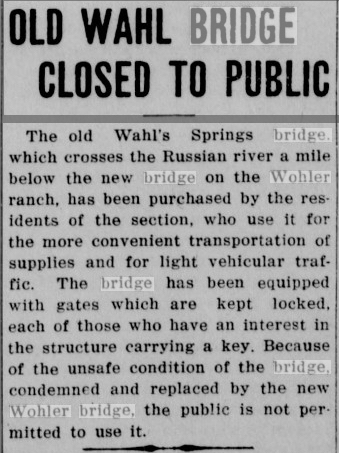
1924, The Wall's Ford Bridge was closed as traffic was rerouted to the Wohler (Red Hill) Bridge.
HILTON
In the late 1800s, the Hilton community, a mile from the McPeak farm, used to have a bit of urban bustle about it with its post office and Brown's General Store. It sat on the Ridenhour ranch and was named for Louis W. Ridenhour's son, Hilton Baker Ridenhour. The proper address of Cosmo Farm was Hilton. The Ridenhours were the first "white" settlers on this stretch of the river and were close friends of the McPeak family when they first came to the area. Louis E. Ridenhour ( son of Louis W.) and Thomas Brown (son-in-law of Louis W.), built a brick factory in Hilton in 1906. The factory was made possible by two factors. First, trains could transport bricks from the factory to distributors, and a side rail was built just for that. Second, it had a clay resource. A newspaper article mentioned a 46 acre clay deposit adjacent to the plant. I speculate that the campground we know as River Bend is in the bottom of a strip mine which has been dug out for the brick clay. A large hole across the road also indicates a digging on the North side of Westside Road.
The business seems to have had ups and downs over the years and closed in 1912, but it was producing 10-12 million bricks a year at its peak. In 1916 it was sold to Thompson Brick Company. Little remains of the structures today.
More information on the brick factory can be found here: http://calbricks.netfirms.com/brick.pureclay.html
The business seems to have had ups and downs over the years and closed in 1912, but it was producing 10-12 million bricks a year at its peak. In 1916 it was sold to Thompson Brick Company. Little remains of the structures today.
More information on the brick factory can be found here: http://calbricks.netfirms.com/brick.pureclay.html
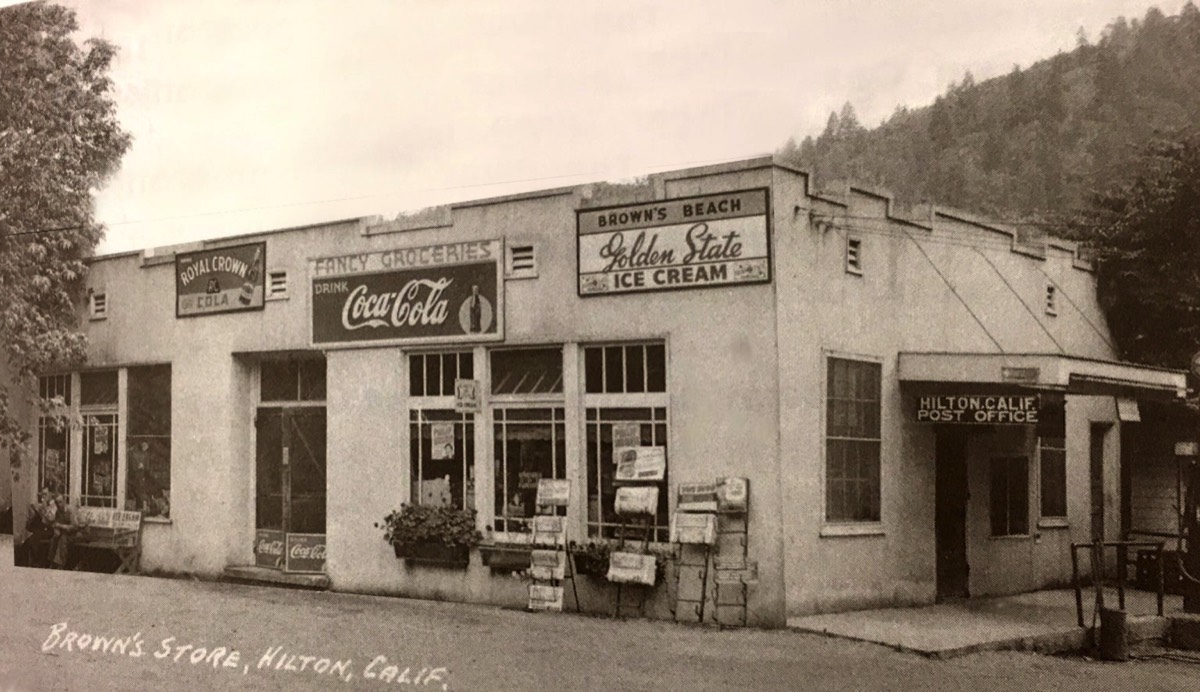
Brown's store, gas station and US Post Office. The name originally selected for Hilton was "Pottery," due to the clay found in the area. But it was decided to call it "Hilton" after Louis Ridenhour's son. Photo taken in 1937. The post office was started in 1894 and closed in 1953.
The Hilton Resort was run by Emily Brown, daughter of Louis W, after her husband, Thomas P, died.
The Hilton Resort was run by Emily Brown, daughter of Louis W, after her husband, Thomas P, died.
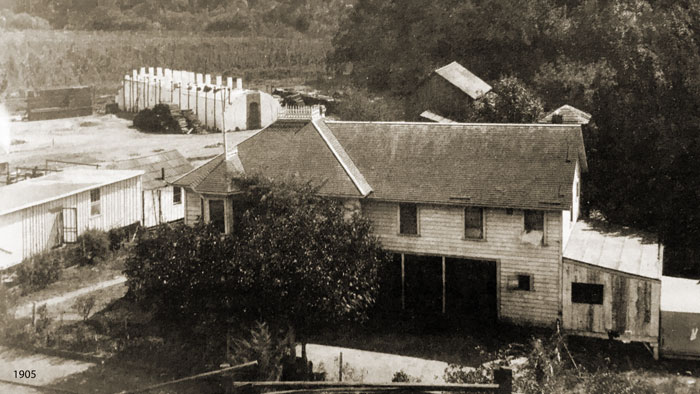
Hilton Hotel in 1905
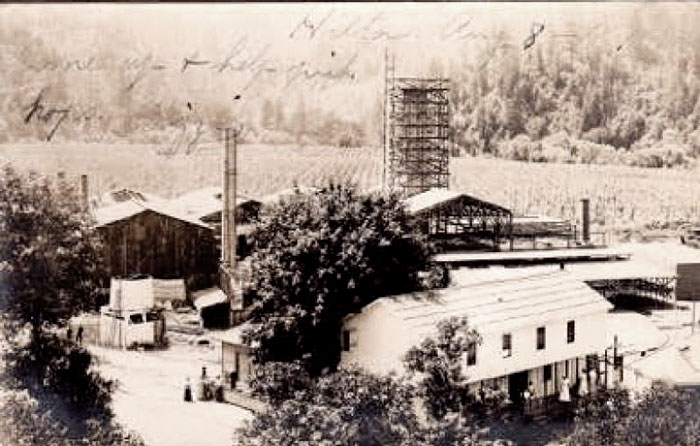
The Hilton Brick Factory. Notice people on porch bottom right.
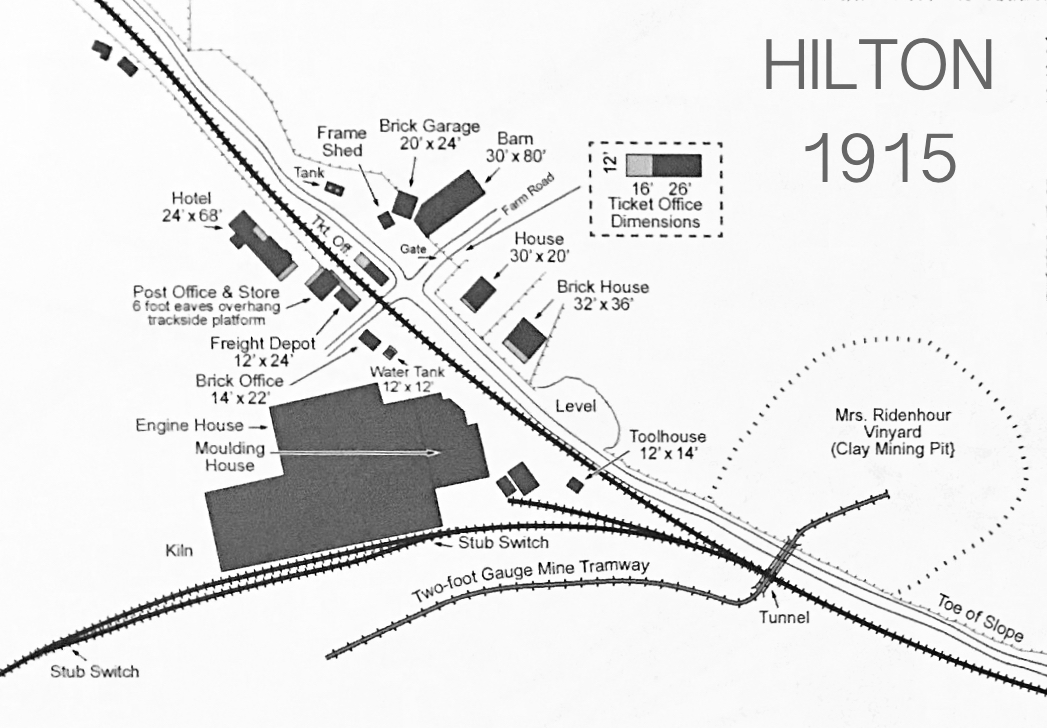
Bricks were in high demand after the San Francisco earthquake so the Hilton Brick Company became very successful.
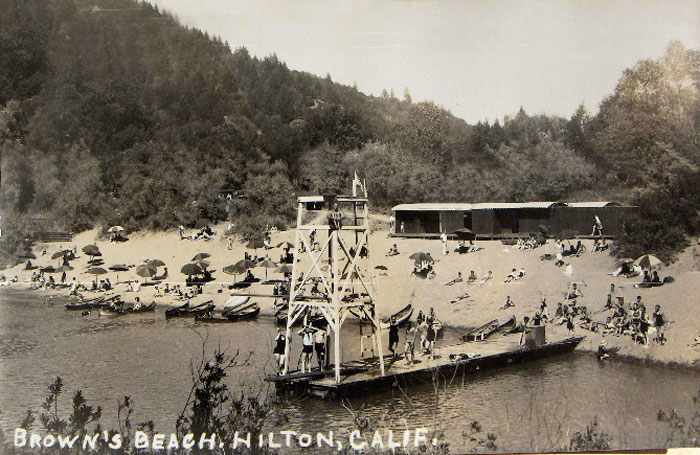
Brown's Beach was one of the most popular of the beaches drawing crowds from the resorts of Highcroft and Summerhome Park across the river. Thomas Brown, grandson of Louis Ridenhour, also ran Brown's Farm Resort and the general store at Hilton.
SUMMERHOME PARK
I have focused on the west side of the river, but Summerhome Park on the east side has always, even in 2017, had a pedestrian bridge to the west side and freely intermingled with Hilton.
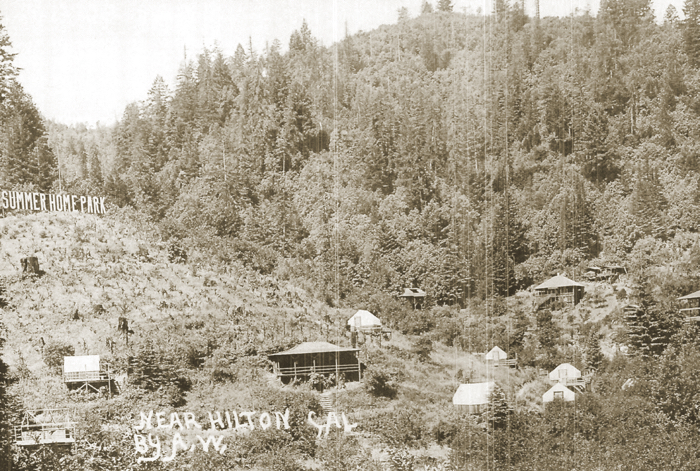
Summerhome Park in the early 1900's.
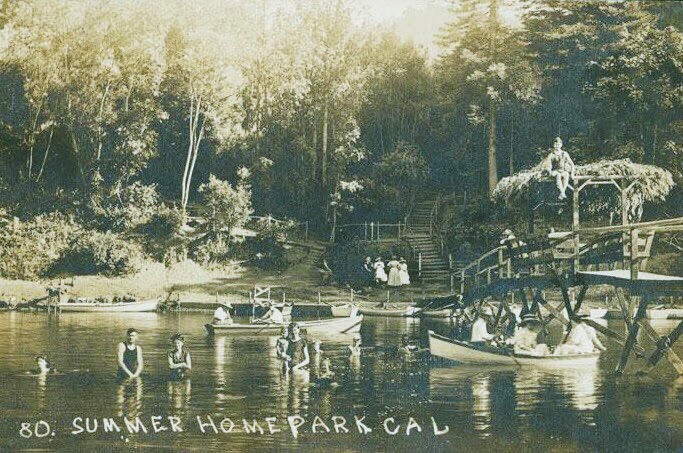
Summerhome Park in the 1930's.
HOLLYDALE PARK
Hollydale park was a sub-division development project in 1929. Joe Pohley purchased land west of Green Valley Creek and sold sites for vacation homes.
In 1947 the neighborhood purchased property to build a social gathering place for the community, The Hollydale Community Club. It is still open in 2018.
In 1947 the neighborhood purchased property to build a social gathering place for the community, The Hollydale Community Club. It is still open in 2018.
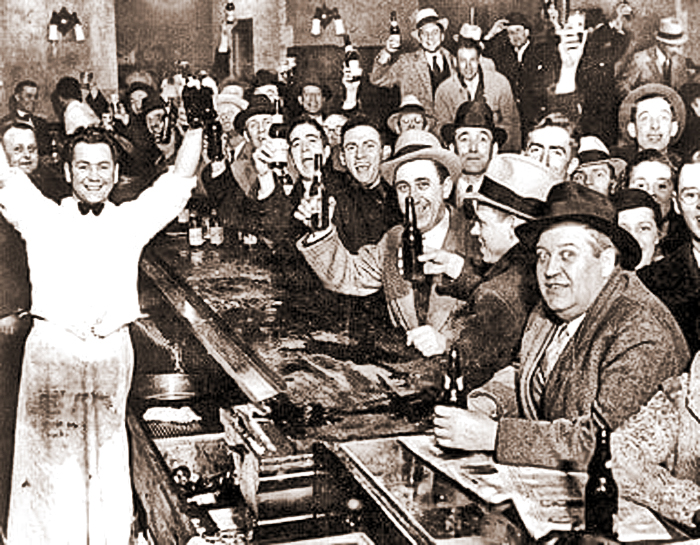
Hollydale Club in 1947 when it first opened.
MIRABEL PARK
Mirabel Park near Forestville was popular as a picnic ground in the late 1800s. But F. Butler, who owed the stretch of redwoods along Mark West Creek and Russian River became disgusted with the trash, the noise, and the general unabashed behavior of the users.
His solution, in 1901, was to lease the property to The Literary Club of San Francisco for use as a literary retreat. It featured a tent hotel, and most importantly, a string of renown guest speakers who would lecture the audience on nature, life, science, art, travel and more.
His solution, in 1901, was to lease the property to The Literary Club of San Francisco for use as a literary retreat. It featured a tent hotel, and most importantly, a string of renown guest speakers who would lecture the audience on nature, life, science, art, travel and more.
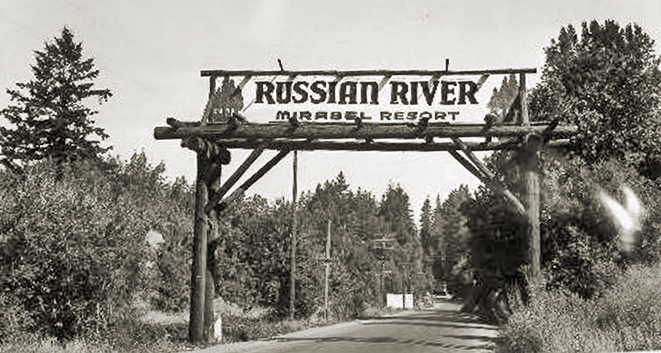
Mirabel Park was hugely popular due to the ease of access.
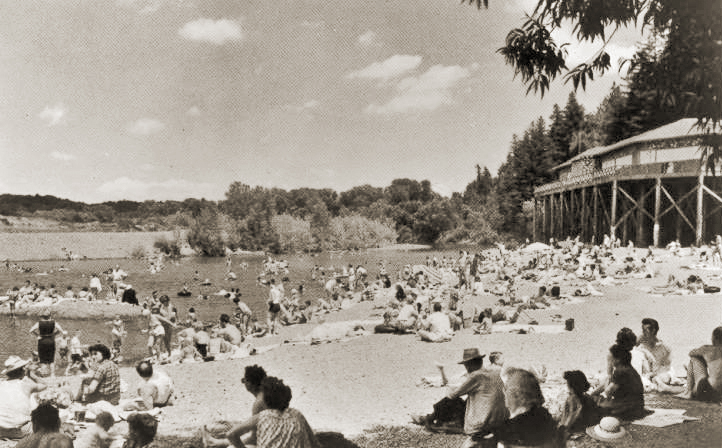
In the 20s, Mirabel had a skating rink, visible above, which also featured famous big bands for weekend dance events.
WINE AND BEER AND MAYBE MORE
While not directly a part of the Hacienda story, I would feel neglectful were I not to mention that while Hacienda is in the redwoods, it is on the edge of the redwoods, and beyond those amazing trees is a fantastic agricultural land for growing grapes and hops. Westside Road, which connects Healdsburg and Hacienda, has become the home of some of Russian River Valley's finest Pinot Noir vineyards referred to as the "middle reach."
One of the more respected wineries on Westside Road is Williams-Selyem. They were residents of Hacienda in the '70's making wine in a garage. In 1981 they made the winery legal and named it Hacienda del Rio. The first commercial release of Hacienda del Rio wine was in 1983. A similarly named winery made them change the name and they become Williams-Selyem.
By the mid 90's they had become one of the most respected wineries in the world and the wines were served at the White House in 1995. The winery has exchanged hands since that time.
There are, in 2017, fourteen Russian River Valley wineries between Hacienda and Dry Creek on Westside Road.
One of the more respected wineries on Westside Road is Williams-Selyem. They were residents of Hacienda in the '70's making wine in a garage. In 1981 they made the winery legal and named it Hacienda del Rio. The first commercial release of Hacienda del Rio wine was in 1983. A similarly named winery made them change the name and they become Williams-Selyem.
By the mid 90's they had become one of the most respected wineries in the world and the wines were served at the White House in 1995. The winery has exchanged hands since that time.
There are, in 2017, fourteen Russian River Valley wineries between Hacienda and Dry Creek on Westside Road.
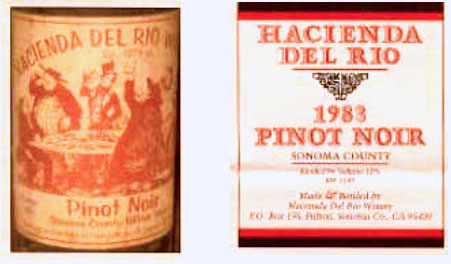
Before there were massive vineyards, there were massive hop fields. Anthony McPeak farmed both hops and grapes on his property on Hobson Creek.
Russian River Brewing Company was created in 1997 when Korbel decided to try their hand at brewing beer. Brewer, Vinnie Cilurzo, was hired as brewmaster. Brettanomyces were first used with local wine barrels in 1999 for production of sour beers. Korbel sold the brewery to Cilurzo and his wife Natalie in 2002. Cilurzo is regarded as one of the most innovative microbrewers in the country and Russian River Beer is highly regarded in the beer world.
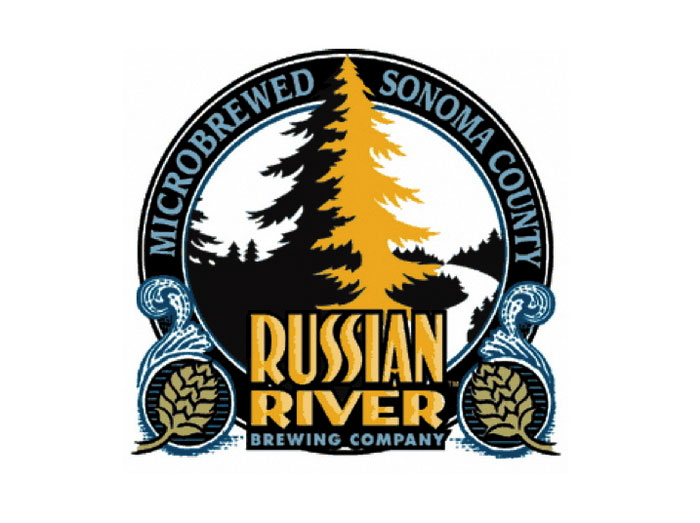
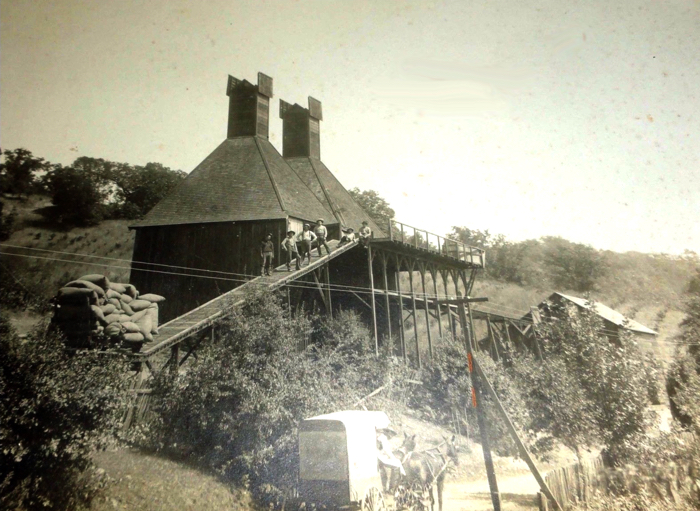
Kiln located West Side Russian River. Also in photo meat wagon of "The People's Market," Porter & Co.
Shows: Ernie Sinall; Clarence Bruer; Fred Burkhoffer; Floyd Ballinger; Warren Jones; Carl Peterson.
Photograph taken Sept 1909
Shows: Ernie Sinall; Clarence Bruer; Fred Burkhoffer; Floyd Ballinger; Warren Jones; Carl Peterson.
Photograph taken Sept 1909
As marijuana becomes legal, the expectation is that hemp growing will become a major crop in the area in the next few years.
RESORTS
Cosmo Farm may have been the first resort in the area, but its success resulted in other resorts opening. Once the train came in, everyone opened resorts. There was a demand for them. Tourism was booming.
Resorts could come an go pretty easily and many were very small. They deserve to be remembered as well.
In 1905:
Mirabel Park Ranch — Mirabel Park.
Few minutes walk from station. Junction of Mark West Creek and
Russian River; hunting, fishing, boating and swimming.
Plenty of shade. Croquet grounds. Can accommodate 30
in rooms or tents, whichever is preferred.
Adults, $8.00 to $10.00 per week; children under 10,
$5.00 per week. Furnished tents, for housekeeping,
$10.00 per week. Address Le Roy Blake, Forestville,
Sonoma, Cal.
Camp Purrington — Green Valley.
One-quarter of a mile from station. On Russian River at the mouth
of a beautiful canon and at the foot of Mt. Jackson.
Fishing, boating and bathing. Shade trees surround
the house; orchard. First-class tent accommodations.
Adults, $8.00 per week; children according to age. Ad-
dress S. W. Purrington, Healdsburg, R. F. D., Sonoma
County, Cal.
Bohn’s — Green Valley.
Half-mile from station, where guests will be met. On the banks of Russian
River ; boating, fishing, and bathing. Can accommodate
12. Adults, $7.00 per week. Address Mrs. A. Bohn,
Healdsburg R. F. D. No. 1, Sonoma County, Cal.
Road’s End Farm — Green Valley.
One mile from station, where guests will be met. One hundred yards
from Russian River; mile frontage on the river; boat-
ing, bathing, fishing, and swimming; 3 bath-houses
on the river, with spring-boards; five boats; rising
hills, well wooded, for outings; plenty of shade; iron
and borax springs; cold spring water; croquet-grounds;
guests sleep in tent-cottages, well furnished, and water
piped to all of them; telephone in the house; dancing
floor, 20x40. Open from June 1st till October 1st. Can
accommodate 30. Adults, $2.00 per day, $10.00 per
week; children, $4.00 and upwards per week, accord-
ing to age; parties of 4 or more, $8.50 per week.
Address Charles E. Ogburn, Road’s End Farm,
Hilton P. O., Sonoma County, Cal.
Wall’s Springs — Green Valley.
Half-mile from station; will meet guests. In the hills, among the red-
woods; elevation 500 feet; plenty of shade; lovely surroundings; mineral springs, — iron, sulphur, and magnesia ; mineral baths; sulphur baths free to guests; half-mile from Russian River; fishing, bathing, and boating;
hammocks and swings; telephone; daily mail. Can
accommodate 100. Adults, in hotel, $8.00 per week, in
cottages, $7.00; children under 12, $4.00 per week;
special rates for families. Address Mrs. C. N. Meredith,
Healdsburg R. F. D. No. 1., Sonoma County, Cal.
Isaacs Farm — Green Valley.
Three miles from station, where guests will be met. Quarter-mile from
Russian River; boating, fishing, and hunting; plenty
of shade; swings, hammocks, and croquet; canvas
bath-house at river. Open for guests from May 1st till
September 30th. Can accommodate 40 in house and
tents. Adults, in house, $8.00 per week; in tents, $7.00
per week; children, according to age; special rates for
families. Address Mrs. A. Isaacs, Healdsburg R. F.
D. No. 1, Sonoma County, Cal.
Cosmos Farm — Camp Six.
Two hundred yards from station; will meet guests.
In the beautiful redwoods of Russian River Valley;
good spring water; shady nooks; grand
mountain scenery; one mile and a half
fronting on Russian River; fishing, swimming and
boating; daily mail; long distance telephone. Open
from May till September. Can accommodate 150 in
house and tents. Adults, $10.00 to $12.00 per week.
Address Mrs. A.I. Misner, Hilton, Sonoma County,
Cal.
Hilton Farm Home - Hilton station
One hundred feet from station; one hundred yards from Russian
River. Five miles from Guerneville. Can accommodate 40.
One and one-half miles good deep water for
bathing and boating; bath-houses at the river. Boats
rented to guests for $2.00 per week. Rates for adults,
$7.00 to $8.00 per week; children under 9 years $3.50
per week. Postoffice and store at station. Three acres
of grove between house and river for swings, hammocks,
dancing and camping. Water piped to the ground for
campers. Campers may furnish their own tents or
obtain them on the grounds. Cottage for rent for light
housekeeping with table, stove and springs. I have
for sale a tract of forty acres of fine land which
I will sell in any size lots to suit the purchaser. This
land faces the Russian River and is covered with beautiful
trees, such as redwood, laurel, madrone and fir;
good fishing and boating; also plenty of good natural
spring water, making it an ideal spot for summer homes.
Address T. P. Brown, Hilton, Sonoma County, Cal.
Esterville — Korbel
Directly across the river from station; will meet guests.
Two miles from Guerneville; beautifully situated; quiet surroundings;
numerous trails leading to points of interest and fine views; boating,
bathing and fishing; everything new and first-class.
Adults, $10.00 per week; children under 10, half-rates;
special rates for families. Address G. W. Esterlinq,
Box 83, Guerneville, Sonoma County, Cal.
I suspect that Esterville was formerly known as Rio Vista Ranch. It was operated by C.E. McPeak.
RIO DELL RESORT
As a result of the success of resorts along the river, Rio Dell was established between Mirabel Park and Green Valley in the early 1930s. The land was originally the estate of H. B. Litton, and the resort was sometimes referred to as "Litton." Mr. Litton lived on the property until his death in 1941.
RIVER ROAD
The main transportation corridor though our area is River Road. It is easy to take it for granted. But the road didn't exist until after the railroad was gone, in fact it is basically the train right-of-way. Before the train was built, the main road was Westside (West Side) Road. It started in Healdsburg and petered out at the Ridenhour Ranch a half mile beyond Cosmo. The Russian River canyon was too rugged to build a road further until quite a bit later. The only road to Guerneville was not Westside, it was Sweetwater Springs Road.
But that changed once the railroad became a roadway, and the rail bridge became a bridge for noisy smoggy cars. In 2005 we had over 10,000 cars a day go through Hacienda. That number is obviously much higher now.
MUSIC
Again, not directly a part of the Hacienda story, the mid-1920's to the 1940's was when Russian River was most popular, and part of that popularity was the big-name bands, like Benny Goodman (below,) who came through the area. Cosmo had a large outdoor dance platform, but the real hot places were the huge dance halls in Mirabel Park, Rio Nido and Guerneville. These places were only four or five miles away so represented an attraction for guests in Cosmo and Hacienda as well.
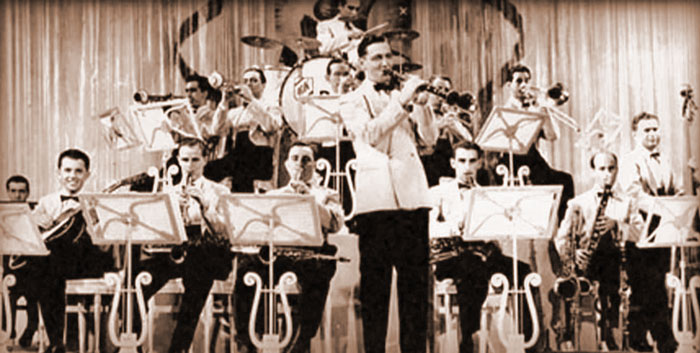
Benny Goodman and his Orchestra
PAUL BUNYAN, FORT COOK, THAT CONCRETE THING,
THE OLD HIDING PLACE, THE RUSSIAN RIVER PUB
THE OLD HIDING PLACE, THE RUSSIAN RIVER PUB
These are a things visitors ask about.
The concrete structure at Steel Head Beach is what is left over from a gravel mining business. There were several gravel plants operating in Russian River, including, perhaps, one at Hacienda that may not have ever been built.
Fort Cook is not actually a fort. it is a disguise for Fort Cook Construction, hiding all the messy equipment that a construction company has laying around. A tunnel there goes under River Road to Cook's Beach.
Paul Bunyan is a Muffler Man. Muffler Men are fiberglass giants found all over the USA in a variety of styles. They were originally made in the 1960's to promote roadside businesses. River Bend Campground at Hilton got theirs in the '80's. He has held a shovel and a paddle but now he holds an ax. Supposedly he used to have a built-in speaker that told the story of Paul Bunyan.
The Old Hiding Place was a gay bar in the late '90s. It was owned by "Hans" Grahlmann who also owned the Rainbow Cattle Company, Stumptown Brewery and other local businesses. He was murdered in his Monte Rio home in 1998. The building was refurbished in 2017 though I do not know if it will become a commercial operation.
The Russian River Pub was built in 1972. It had been formerly named "Safeway Bob's." Wendy Illg purchased the Pub in May of 2005 and has continued to operate it as a popular restaurant and bar.
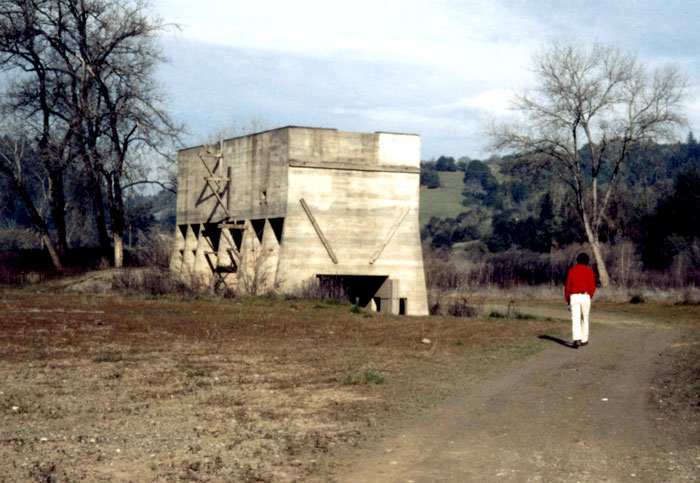
The remains of the gravel production plant at Steelhead Beach shown in 1976.
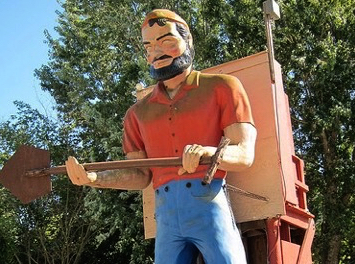
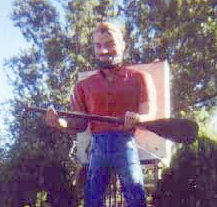
FLOODS
The Russian River floods. We all know it, we all live with it. The worst was in 1862, though it wasn't just the Russian River. The entire West Coast was hit by what is often called a 200 year storm. California's Central Valley turned into a sea. Weather record keeping had not started yet, but it is reported that Santa Rosa got 58 inches in just a few weeks. There has been no storm of that magnitude in the USA since. It is certain that the Russian River gave Hacienda a good washing. The McPeaks would have been living at the Korbel property at that time.
Some notable floods: 1879 (considered the worst since record keeping began), 1914, 1937, 1940, 1955, 1964, 1986.
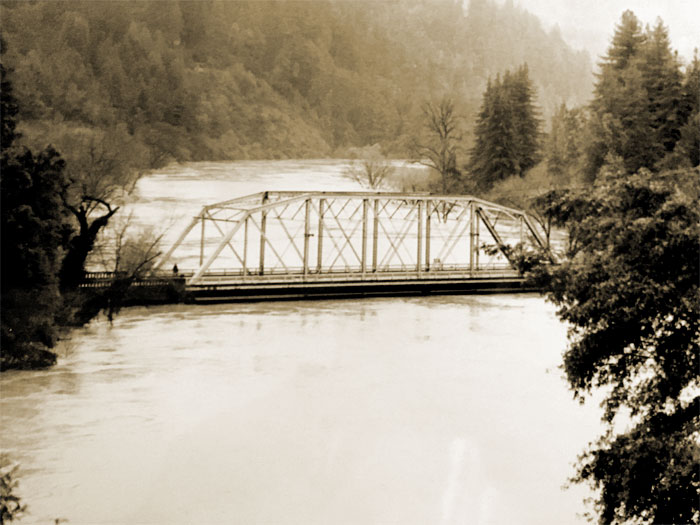
Hacienda Bridge barely keeping above flood waters in 1986. Photo courtesy Phil and Julie Grosse.
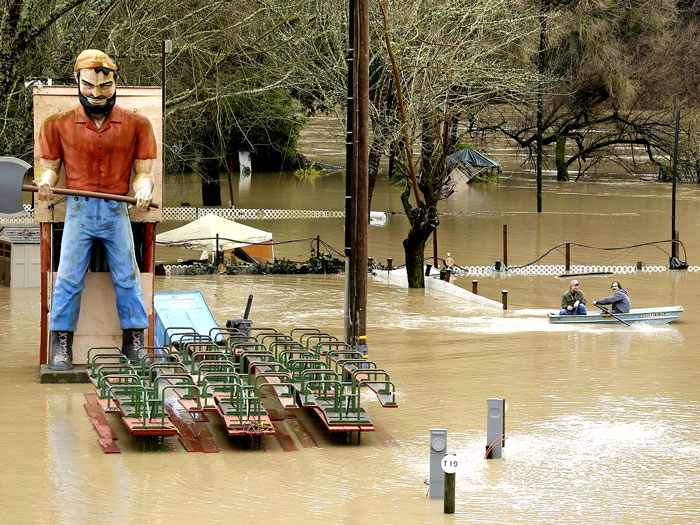
River Bend Campground in Hilton, 2017.
NORTHWEST PACIFIC RAILROAD
The importance of the railroad to the area should not be understated. The trains ran from 1876 to 1935 and were a source of pleasure to thousands who descended into the redwoods. Oh, they also did profitable work for the lumber mills.
Here is engine number 11. An old wood burner. It was scrapped in 1907.
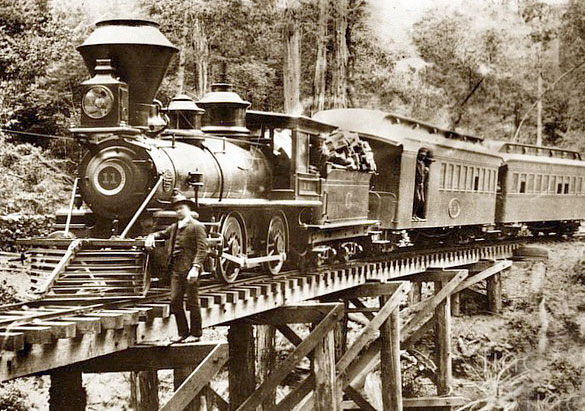
SONOMA COUNTY WATER AGENCY
Just downriver from the Wohler Bridge is the Sonoma County Water Agency unique inflatable dam that helps control water flow for drinking water as well as protecting our salmon and trout.
There is also an educational center at the Wohler Bridge that includes the ability to watch the salmon swim through the fish ladder during migration. It is located three miles upstream from Hacienda.
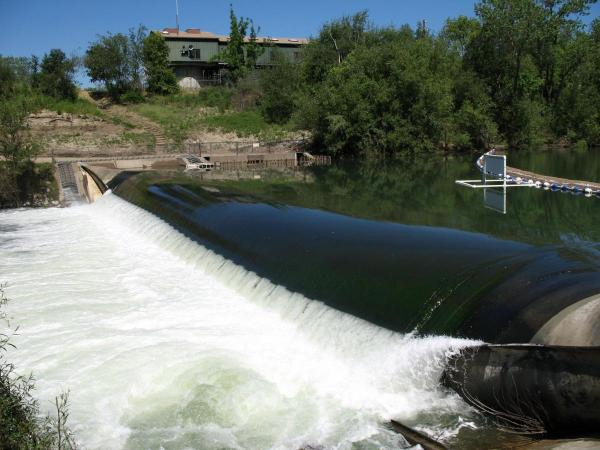
NATIVE AMERICANS
I have found little to no evidence of a Native American settlement in the Hobson Creek valley. I only bring it up because I did run into one item that indicated there was a permanent Native American village here called Budutcilan.
Research has turned up that Budutcilan was located upstream several miles at the site of, in 2017, Arista Winery. I have run into accounts of Native American's seasonal relocations between the coast and Dry Creek Valley using Westside Read, but there is little record of Native Americans in newspapers in the 1800s which were owned and operated by European Americans for a European American readership.
A Pomo village existed at the mouth of the Russian River (I think), called A-kow-wah-tol.
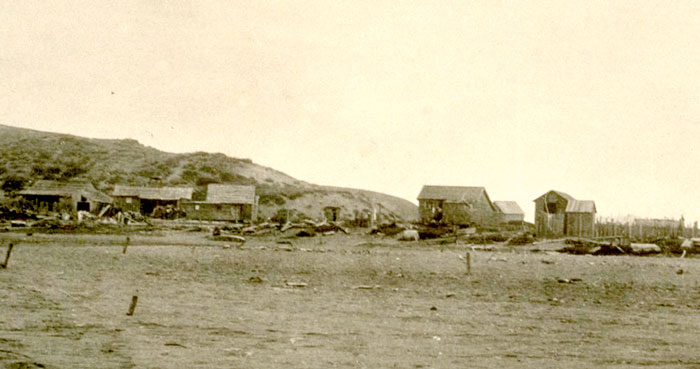
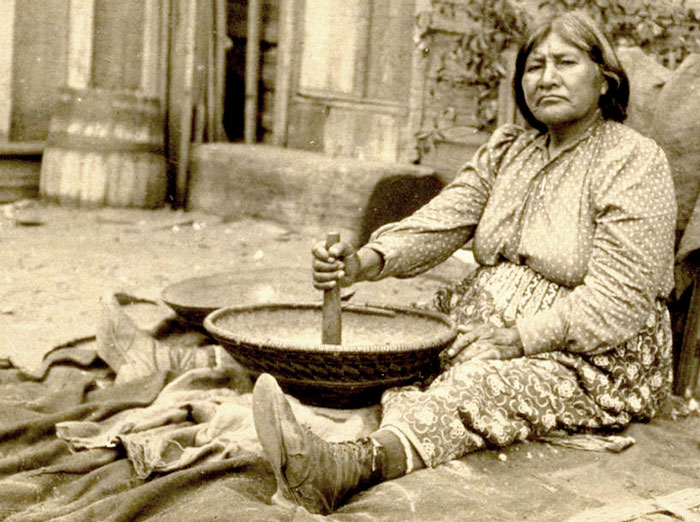
The Pomo village of A-kow-wah-tol (top) Pomo resident of A-low-wah-tol (bottom) in 1905.
PHILOSOPHY - DIVERSITY
The Russian River area in general has a kind of conservative liberalism. It goes something like, "you stay out of my business and I stay out of yours." The result is that the river is populated by a wide range of people who seem to live together with a sense of community, while still being individualistic.
The McPeaks, the Ridenhours and even the Korbels did not subscribe to organized religions, so our area did not develop the sense of guilt and repression often seen elsewhere. The cemetery is not overly marked with Christian or other symbolism.
However, the cemetery does indicate a popularity, at least in later years, of the Masonic Order, Odd Fellows, and other social/philosophical organizations. Also, there was a Catholic outreach from Guerneville during the '50s. Services were conducted outdoors among the redwoods.
RUSSIAN RIVER HISTORICAL VIDEO
(Video indicates it is 3:49:00 but it is 43 minutes long.) https://www.youtube.com/watch?v=CE1P7Uf7I0c